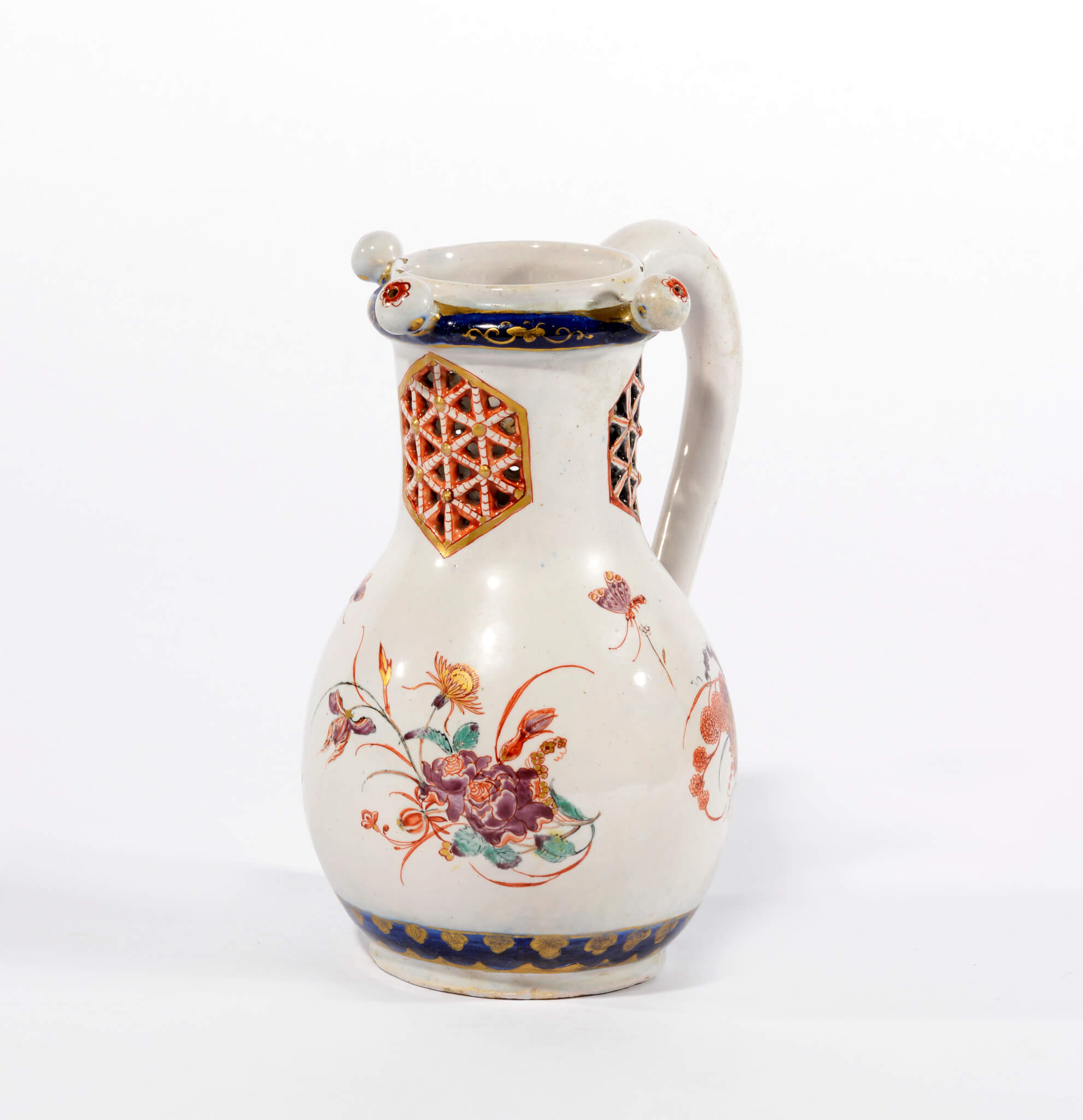
[popup_trigger id=”13756″ tag=”span”]![]() [/popup_trigger]
[/popup_trigger]
Images on this website are licensed under a
Creative Commons Attribution-NoDerivs 3.0 Unported License.
OBJECT
D1618. ‘Petit Feu’ Polychrome and Gilded Puzzle Jug
Delft, circa 1730
Painted around the pear-shaped body with three winged insects and a snail between three clusters of iron-red, manganese, green and gold flowers above a blue border embellished with gilt leaves and a scalloped band above the footrim. The cylindrical neck pierced with three hexagonal panels of trelliswork heightened in ironred and gold beneath the blue-ground tubular rim decorated with four gilt scroll devices between the three spherical nozzles and the tubular loop handle, its outer edge with three beribboned leaves.
Height: 19.6 cm. (7 11/16 in.)
Note:
Through the centuries puzzle jugs have appeared in Italian, German, French and English ceramics and occasionally in other mediums, but it was not until the second half of the 17th century that they developed a certain popularity, and examples began appearing more frequently at that time. Although models from other countries are very uncommon, Dutch puzzle jugs are particularly rare. Dutch Delft examples can be found dating from the 1650s onward through the 18th century, which was their most popular period, and during which they even inspired the Chinese potters to produce puzzle jugs in porcelain.
Since it was difficult to produce these jugs, and based on the fact that they are often dated, they probably were produced on special order. Moreover,
inventory lists of the factories and of the potters’ shops occasionally mention a so-called ‘suijgkan’ (‘suction-jug’), which refers to these vessels. The name ‘suijgkan’ hints at the secret of solving the puzzle of the jug. It was not the intention to pour or drink from it like a normal jug or tankard, as the pierced openwork on the neck of the jug makes clear. The jugs were intended as a game or a conversation piece during a dinner party. The answer of solving the puzzle is in the trick of the construction. Generally the hollow tubular rim has one functioning nozzle, and two or more ‘dummy’ nozzles issuing from a tubular rim that is connected to the hollow handle, which forms a siphon from the lower body. The suction, however, is broken by a small hole beneath the top of the handle, and the solution to the puzzle is for the drinker to place his thumb over the hole in order to create the vacuum that allows him to suck the liquid from the jug up through the handle, around the rim and out through the one functioning nozzle.
Similar examples:
A polychrome and gilded puzzle jug of this model and date, but of an unusually small size (14.8 cm. [5 13/16in.]), and with armorial and Chinese figure and floral decoration is illustrated in De Jonge 1965, p. 269, pl.161; Lunsingh Scheurleer 1984, p. 309, no. 345; and Scholten 1986, no. 60 (left). Another of that size and the present model, though with a differently pierced neck, was in the Dr. Günther Grethe Collection, Hamburg, illustrated in Aronson 2004, p. 119, no. 137.
A blue and white puzzle jug, marked GVS for Geertruij Verstelle of Het Jonge Moriaanshooft (The Young Moor’s Head) factory, circa 1761, with European figure decoration but the neck similarly pierced with trelliswork within oval panels, is in the Musée National de Céramique, Sèvres (inv. no. Cl
7473), is illustrated in Forest 1880, p. 138, pl. 130; and Lahaussois 1998, p. 181, no. 169.
Provenance:
The collection of Daniël George van Beuningen (1877-1955); and hence by family descent to 2015








